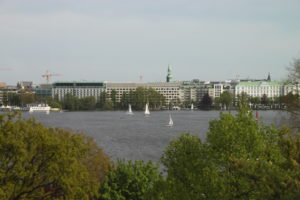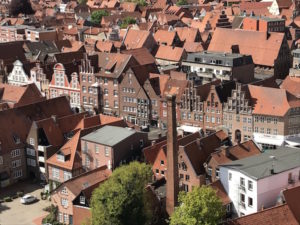Hamburg boasts an exotic new concert facility, opened in early 2017. It is a huge modern glass structure that sits atop a former warehouse. It is popularly known as the “wave” because its roofline is indeed wavy.
And this wave-sitting-on-a-warehouse is perched right at water’s edge in Hamburg’s harbor, on the Elbe River, in the recently redeveloped port area called HafenCity. The concert site is, officially and fittingly, called the Elbphilharmonie.
I attended a concert in the 2,100-seat Grand Hall. Seating is on all sides — music in the round, if you will — and the hall is more vertical than a typical concert space.
The seating areas seem to climb the walls like terraces, which is probably why this organizing style is called “vineyard” in architectural circles. Further, the organ is built into the seats spanning three levels.
There isn’t a straight line in the hall, also no bad seats.
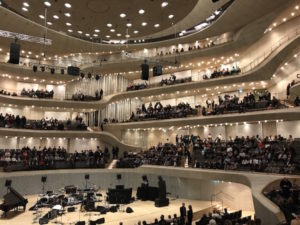
The 2,100-seat Grand Hall inside the Elbphilharmonie, featuring the so-called “vineyard”-style seating arrangement. The vertical lines at left center are the pipes of the organ, which sits among the seats on several levels.
But my theme here is the bird’s-eye view, in this case of Hamburg’s harbor and HafenCity. From the Grand Hall’s foyer, I looked through some of the 1,100 variously shaped glass elements that sheath the building out onto rooftops in and near the harbor, as well as at some of the new buildings that characterize HafenCity.
The Elbphilharmonie also accommodates, either in the original seven-story warehouse or within the 18-story glass add-on, other concert halls, restaurants, a 244-room hotel and some residential housing. The warehouse, built to replace one destroyed in World War II, was sitting on 1,111 concrete piles, but another 650 were added so the warehouse could support all these new things.
All these new things also include the Plaza, a viewing platform that wraps the entire building on the eighth floor. This is where I got my 360-degree views of city and harbor.
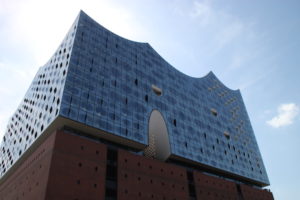
Hamburg’s newest landmark, the Elbphilharmonie, a former warehouse topped by a dramatic glass structure housing the Grand Hall, a hotel, apartments and other facilities. The gap between the brick and glass components accommodates the Plaza, a viewing space that encircles the building.
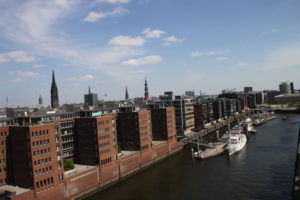
View of HafenCity, Hamburg’s redeveloped harbor area, seen from the Elbphilharmonie’s Plaza viewing area.
Just above the former warehouse, at 121 feet above the street, the Plaza is open to anyone although tickets are required. Presumably, this is to manage crowd sizes; the Plaza attracted 2.5 million in its first five months. Same-day tickets are free; there is a small fee to book ahead.
To accommodate the outdoor Plaza, the walls at this level are recessed so that visitors are always within the outer parameters of the Elbphilharmonie’s upper and lower parts. The new glass structure overhead provides shade.
Entry and exit to and from the Plaza walkway is via doors in S-shaped glass walls that, in two places, sweep arc-like into a large open foyer, creating two large outdoor terraces well sheltered from weather and the wind.
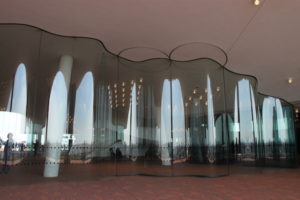
Glass walls that surround portions of the Elbphilharmonie’s Plaza level. Reminiscent of the building’s roofline, these walls also suggest waves due to their undulating formations. For this photo, I was standing outdoors looking in.
Numerous Elbphilharmonie features regarding doors and apartment balconies (inset balconies, not jutting out over the streets or river below) are designed to let the winds pass through without causing damage (and maybe to avoid blowing people away?). And it WAS windy on the Plaza.
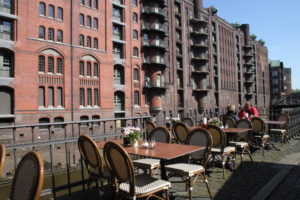
A small section of the UNESCO-protected warehouse district for which Hamburg is well known. The district, called Speicherstadt, is adjacent to HafenCity. If there is a way to have a bird’s-eye view of these buildings, I don’t know about it. The district has eateries, such as the one seen here, but no one lives there due to the risk of flooding.
By a fluke, bird’s-eye views were a feature of my few days, this May, in northern Germany. Others were:
1) Views of Alster Lake in the middle of Hamburg, from the newly opened lakeside luxury hotel, called the Fontenay.
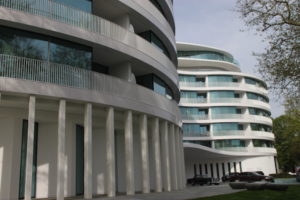
Exterior of the Fontenay hotel, opened in March 2018. Sitting at the side of Alster Lake, the property features three entwined circular buildings.
Designed as three linked circles, which create eye-catching atrium spaces, the hotel offers lake views from many rooms, but the broadest are from the Fontenay Bar terrace on the seventh floor. These are 320-degree (no, not 360) views of lakeside houses, church steeples — and sailboats on a sunny spring day.
2) Views of Lubeck’s city hall, 15th century city gate, churches and gabled houses, seen from St. Peter’s Church. The church, like some of the medieval city center’s other historically significant buildings, was reconstructed after World War II destruction.
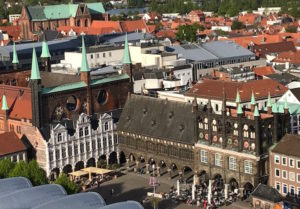
Lubeck’s city hall, seen from St. Peter’s Church in the city’s medieval center. The three attached buildings seen facing a plaza comprise the city hall. The city hall and St. Peter’s had to be mostly or entirely rebuilt after World War II.
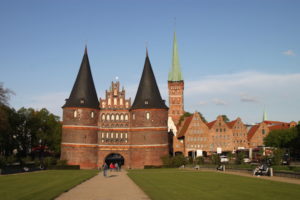
At center, St. Peter’s steeple, which provides the vantage point for bird’s-eye views of Lubeck’s city center. In the foreground are the medieval Holsten Gate and several of the warehouses dating from Hanseatic League days. The gate and warehouses survived World War II bombing.
Lubeck was the lead city in the Hanseatic League, a medieval union of German trading centers. The historic center, located on an island in the Trave River, is now UNESCO protected.
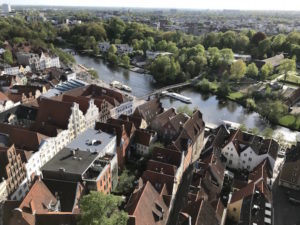
View of Lubeck rooftops and a stretch of the Trave River, which surrounds the city’s historic center.
3) Rooftop views of another Hanseatic League member, Luneburg, an important trading site because it produced mountains of salt in a day when there was no refrigeration. The stuff was called “white gold.”
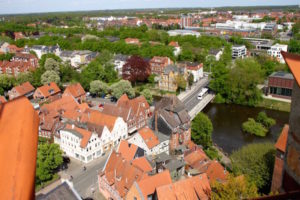
Above and below, differing overhead angles on the charming medieval section of Luneburg. The water tower viewing platform offers a 360-degree perspective on life below.
An early 20th century water tower provides the 21st century viewing platform for eying a medieval center that was not damaged in World War II. Hundreds of buildings are locally protected.
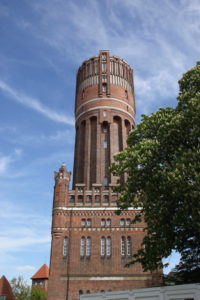
The early 20th century water tower that provides the viewing platform for bird’s-eye views of the medieval Luneburg.
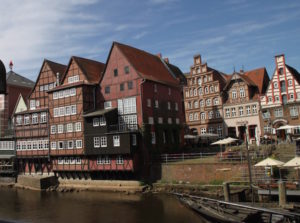
The old port area of Luneburg, which is just outside the area one can see from the water tower — but it photographs so well it cannot be left out here!
For more about the region discussed here, we offer at BestTripChoices.com the following, under the headline: In League with one another. (By the way, Hamburg was in the Hanseatic League, too.)
https://besttripchoices.com/international-touring-areas/balticnorth-sea-coasts-germany/
This blog and photos are by Nadine Godwin, BestTripChoices.com editorial director and contributor to the trade newspaper, Travel Weekly. She also is the author of “Travia: The Ultimate Book of Travel Trivia.”

